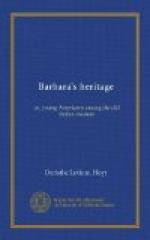At Mr. Sumner’s invitation all sat on the steps in a sunny corner while he talked of Cimabue,—the first great name in the history of Italian painting,—the man who was great enough to dare attempt to change conditions that existed in his time, which was the latter part of the thirteenth century. He told them how, though a nobleman possessing wealth and honor, he had loved painting and had given his life to it; and how, having been a man arrogant of all criticism, he was fitted to be a pioneer; to break from old traditions, and to infuse life into the dead Byzantine art.
He told them how the people, ever quick to feel any change, were delighted to recognize, in a picture, life, movement, and expression, however slight. How, one day six hundred years ago, a gay procession, with banners and songs, bore a large painting, the Madonna and Child, from the artist’s studio, quite a distance away, through the streets and up to the steps on which they were sitting; and how priests chanting hymns and bearing church banners came out to receive the picture.
“And through all these centuries it has here remained,” he continued. “It is, of course, scarred by time and dark with the smoke of incense. When you look upon it I wish you would remember what I told you the other evening about that for which we should look in a picture. Be sympathetic. Put yourself in old Cimabue’s place and in that of the people who had known only such figures in painting as the Magdalen you saw last week in the Academy. Then, though these figures are so stiff and almost lifeless, though the picture is Byzantine in character, you will see beyond all this a faint expression in the Madonna’s face, a little life and action in the Christ-child, who holds up his tiny hand in blessing.
“If you do not look for this you may miss it,—miss all that which gives worth to Cimabue and his art. As thoughtful a mind as that of our own Hawthorne saw only the false in it, and missed the attempt for truth; and so said he only wished ’another procession would come and take the picture from the church, and reverently burn it.’ Ah, Malcom, I see your eyes found that in your reading, and you thought in what good company you might be.”
“What kind of painting is it?” queried Barbara, as a few minutes later they stood in the little chapel, and looked up at Cimabue’s quaint Madonna and Child.
“It is called tempera, and is laid upon wood. In this process the paints are mixed with some glutinous substance, such as the albumen of eggs, glue, etc., which causes them to adhere to the surface on which they are placed.”
“What do you think was the cause of Cimabue’s taking such an advance step, Mr. Sumner?” asked Howard Sinclair, after a pause, during which all studied the picture.
“It must have been a something caught from the spirit of the time. A stir, an awakening, was taking place in Italy. Dante and Petrarch were in a few years to think and write. The time had come for a new art.”




